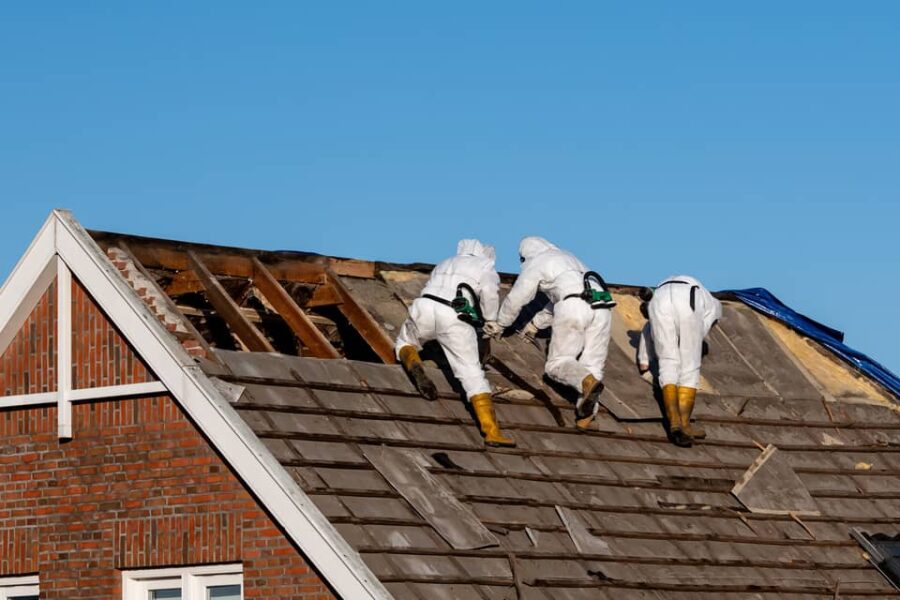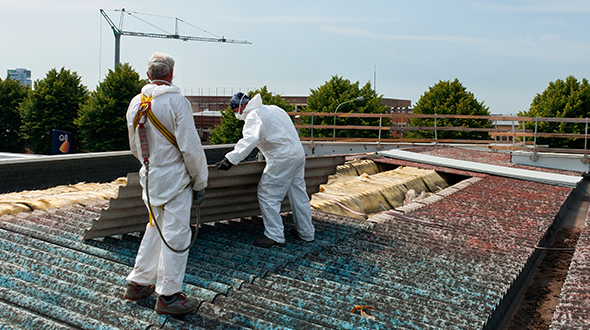Handling Asbestos Shingles And Tiles Safely Hazardous Materials & Disposal Services
Handling Asbestos Shingles And Tiles Safely Hazardous Materials & Disposal Services
Blog Article
Asbestos Waste Transportation Guidelines Removal And Disposal Of Asbestos
Asbestos disposal regulations play a crucial role in safeguarding public health and the environment. As asbestos is a highly hazardous material, proper disposal is essential to mitigate the risks associated with exposure. These regulations are designed to govern how asbestos is handled, transported, and disposed of to make sure that it does not pose a threat to human health or the ecosystem.
The first step in understanding asbestos disposal regulations involves recognizing the nature of asbestos itself. This naturally occurring mineral has been widely used in construction and industrial applications because of its warmth resistance and sturdiness. However, its fibers can turn into airborne, resulting in critical health issues such as lung cancer, asbestosis, and mesothelioma. As a outcome, regulations are stringent, masking each facet from extraction to disposal.
In many regions, disposal regulations usually are not solely ruled at a federal degree but in addition at the state and native ranges. Agencies such as the Environmental Protection Agency (EPA) in the United States have established guidelines concerning the disposal of asbestos waste. These regulations outline how to classify and manage asbestos-containing materials (ACMs), detailing what constitutes hazardous waste.
Prior to disposal, asbestos must be properly recognized and categorized. This requires inspections and sampling by certified professionals. Once an ACM is identified, strict protocols must be adopted to ensure that its disposal is in compliance with regulatory standards. This includes utilizing specialised containers designed to stop the release of asbestos fibers into the air.
Asbestos Roof Removal Machinery And Tools Asbestos Roof Maintenance Services
Transportation of asbestos waste also falls under stringent guidelines. Only licensed waste transporters are permitted to handle and move these hazardous materials. These transporters must adjust to particular procedures to make certain that the asbestos remains contained and doesn't pose a risk during transport. Improper handling throughout this phase can result in accidents or unintended exposure, highlighting the importance of adherence to regulations.
Once the asbestos waste reaches its destination, it should be disposed of at approved landfills or therapy amenities equipped to deal with such hazardous waste. These facilities are specially designed to isolate asbestos to prevent it from contaminating surrounding environments. Furthermore, regulations stipulate that these sites are regularly monitored for compliance, making certain that they effectively comprise the materials.
For residential and commercial initiatives involving asbestos, regulations require proper notification procedures. Property house owners or contractors must inform related authorities prior to any renovation or demolition activities that will disturb asbestos. This requirement is crucial to enlist the mandatory oversight and assist mitigate risks related to exposure to airborne fibers.
Regulations also handle workers’ safety during the dealing with and disposal of asbestos. Training and certifications are mandated to make sure that staff are educated concerning the risks and are geared up with the proper safety gear. This emphasis on worker safety underlines the multifaceted nature of asbestos disposal regulations, extending the safety measures beyond just most of the people.
Local Regulations For Asbestos Handling Cost To Remove Asbestos Garage
Non-compliance with asbestos disposal regulations can result in severe consequences. Fines and legal actions could additionally be imposed against individuals or organizations violating these regulations - Synergistic Effects Of Asbestos Exposure. Moreover, the failure to adhere to disposal standards may find yourself in environmental contamination, which may require pricey clean-up efforts and additional regulatory scrutiny
Despite the stringent nature of these regulations, challenges remain. Some property house owners might try to chop costs by taking shortcuts throughout disposal, which may immediately endanger public health. Recent incidents have highlighted the importance of elevated oversight and community awareness concerning asbestos disposal.
Another important aspect of asbestos disposal is the role of public education. Public Health Implications Of Asbestos Exposure. Without correct awareness, people may interact in hazardous activities, similar to eradicating asbestos from buildings without enough protective measures and permissions. Community packages geared toward informing citizens about the dangers of asbestos and best practices for disposal can greatly enhance safety

The evolution of asbestos disposal regulations reflects ongoing research into the health impacts of asbestos exposure. As scientific understanding grows, changes in regulations may occur to tighten controls or adapt to new findings. Keeping abreast of these developments is essential for contractors, property owners, and waste management entities alike.
Importance Of Monitoring Air Quality During Removal Video Guides For Safe Removal
Asbestos disposal regulations are a significant framework designed to guard each public health and the environment. Compliance with these regulations permits the safe dealing with and disposal of this harmful material, thereby decreasing the potential for exposure. As awareness and schooling initiatives continue to evolve, they play a pivotal position in safeguarding communities from the hazards associated with asbestos.
Effective management of asbestos waste requires collective efforts from regulatory agencies, trade professionals, and the basic public. By adhering to established protocols and selling awareness, the risks associated with asbestos can be significantly mitigated.
Aftercare Following Asbestos Roof Removal Testing, Removal & Disposal Of Asbestos
Ultimately, the continued implementation and enforcement of asbestos disposal regulations are essential for sustaining each environmental integrity and public health.
- Proper identification and assessment of asbestos-containing materials (ACMs) are required prior to disposal to make sure compliance with regulations.
- Licensed waste carriers must be enlisted to move asbestos waste, ensuring that they adhere to native and nationwide laws governing hazardous materials.
Aftercare Following Asbestos Roof Removal Safe, Reliable And Experienced Removal Services
- Disposal sites for asbestos must be specifically designated and outfitted to handle hazardous waste, offering enough safety measures for workers and the environment.
- Documentation of the complete disposal process, together with manifest forms and waste monitoring, is important to verify compliance and for potential future audits.
- Asbestos waste should be securely packaged in approved containers labeled with hazard warnings to forestall unintended exposure during transit and disposal.
Asbestos Roof Removal Timelines And Schedules Cost Guide For Asbestos Removal
- Local authorities could impose particular regulations that increase national guidelines, requiring companies to stay knowledgeable about their regional laws.
- Training and certification for personnel handling asbestos waste are necessary, focusing on safe dealing with practices and emergency response procedures.

- Controlled demolition procedures must be employed when eradicating ACMs, minimizing airborne fibers and guaranteeing safe disposal.
- Public notifications could also be a requirement in some jurisdictions to tell close by residents about asbestos removal and disposal actions.
Removal Of Asbestos Roofing Materials What To Do If You Find Asbestos
- Regular audits and inspections of waste disposal practices help keep adherence to regulations browse around this site and promote steady enchancment in safety more helpful hints protocols.
What are the first regulations governing asbestos disposal?undefinedAsbestos disposal is primarily regulated by the Environmental Protection Agency (EPA) in the U.S., which outlines specific guidelines for handling, transporting, and disposing of asbestos-containing materials (ACMs) to make sure public safety and environmental safety.
How ought to I prepare asbestos materials for disposal?undefinedBefore disposal, asbestos materials should be wet down to attenuate mud and sealed in leak-tight containers or baggage. It's essential to label them properly as containing asbestos and follow local regulations for safe handling.
Where can I get rid of asbestos waste?undefinedAsbestos waste should be taken to a licensed landfill designated for hazardous waste. It's important to ascertain native waste management services as not all landfills settle for asbestos materials.
Indoor Air Quality Post Asbestos Roof Removal Best & Cheap Removal Services Available
Do I want a permit to get rid of asbestos?undefinedMany regions require a permit for the disposal of asbestos to ensure compliance with safety regulations. Check with your local environmental agency for specific requirements in your area.
What are the results of improper asbestos disposal?undefinedImproper disposal of asbestos can result in vital health risks and legal penalties. It might end in environmental contamination and potential exposure to asbestos fibers, which may cause critical health issues, including lung diseases.
Can homeowners eliminate asbestos themselves?undefinedHomeowners are usually discouraged from disposing of asbestos themselves because of the health risks and strict regulations concerned. Hiring licensed professionals ensures safe handling and compliance with legal requirements.
How much does it cost to dispose of asbestos?undefinedCosts for asbestos disposal can vary extensively based on factors such as location, the amount of asbestos, and the disposal method. On common, it might possibly vary from lots of to hundreds of dollars, depending on local rates and contractor charges.
Common Challenges In Asbestos Roof Removal Testing, Removal & Disposal Of Asbestos
Are there specific training requirements for handling asbestos?undefinedYes, people involved in the removal and disposal of asbestos should adjust to OSHA regulations, which regularly require particular training and certification to ensure safety practices are followed.
What paperwork do I want for asbestos disposal?undefinedYou might have to supply documentation displaying that the asbestos was disposed of in accordance with native, state, and federal regulations. This can include manifests or disposal receipts from licensed services.
Report this page